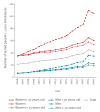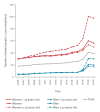Use of healthcare reimbursement data to monitor bacterial sexually transmitted infection testing in France, 2006 to 2020
- PMID: 36177869
- PMCID: PMC9524053
- DOI: 10.2807/1560-7917.ES.2022.27.39.2100618
Use of healthcare reimbursement data to monitor bacterial sexually transmitted infection testing in France, 2006 to 2020
Erratum in
-
Author's correction for Euro Surveill. 2022;27(39).Euro Surveill. 2022 Oct;27(42):221020c. doi: 10.2807/1560-7917.ES.2022.27.42.221020c. Euro Surveill. 2022. PMID: 36268738 Free PMC article. No abstract available.
Abstract
BackgroundDiagnoses of bacterial sexually transmitted infections (STIs) have increased in France since the 2000s. The main strategy to control STI transmission is recommending/facilitating access to condom use, testing, and antibiotic treatments.AimThis study analyses the evolution of STI testing in the private sector in France from 2006 to 2020.MethodsNational health insurance reimbursement data were used to determine numbers and rates of individuals aged ≥ 15 years tested for diagnoses of chlamydia, gonorrhoea and syphilis in the private sector in France and to describe their evolution from 2006 to 2020.ResultsUpward tendencies in testing were observed from 2006 to 2019 for all three STIs. The highest testing rates were identified in people aged 25‒29-years old. The observed testing-increase from 2017 to 2019 was twice as high in young people (< 25 years old) as in older people. In 2019, chlamydia, gonorrhoea and syphilis testing rates were respectively 45.4 (+ 21% since 2017), 41.3 (+ 60%), and 47.2 (+ 22%) per 1,000 inhabitants. For all STIs combined, the number of tested individuals decreased by 37% between March and April 2020 during the first COVID-19 epidemic wave and lockdown in France.ConclusionImprovements found in STI testing rates may have resulted from better awareness, especially among young people and health professionals, of the importance of testing, following prevention campaigns. Nevertheless, testing levels remain insufficient considering increasing diagnoses. In 2020, the COVID-19 pandemic had a considerable impact on STI testing. Partner notification and offering diverse testing opportunities including self-sampling are essential to control STI epidemics particularly in exposed populations.
Keywords: COVID-19 impact; STI; chlamydia infection; gonorrhoea; syphilis; testing.
Conflict of interest statement
Figures






References
-
- Santé publique France (SPF). Estimations nationales et régionales du nombre de diagnostics d’infections à Chlamydia et à gonocoque en France en 2016. [National and regional estimates of the number of Chlamydia and Gonnorhoea infections in France in 2016]. Saint-Maurice: SPF; 2018. Available from: https://www.santepubliquefrance.fr/maladies-et-traumatismes/infections-s...
-
- Ministère des solidarités et de la santé. Stratégie nationale de santé sexuelle, agenda 2017-2030. [National sexual health strategy, 2017-2030 agenda]. Ministère des solidarités et de la santé; 2017. Available from: https://solidarites-sante.gouv.fr/IMG/pdf/strategie_nationale_sante_sexu...
-
- Agence nationale d’accréditation et d’évaluation en santé. Evaluation du dépistage des infections uro-génitales basses à Chlamydia trachomatis en France. [Evaluation of screening for lower urogenital infections due to Chlamydia trachomatis in France]. Agence nationale d’accréditation et d’évaluation en santé; 2003. Available from: https://www.has-sante.fr/jcms/c_464119/fr/evaluation-du-depistage-des-in...
-
- Haute Autorité de Santé. Réévaluation de la stratégie de dépistage des infections à Chlamydia trachomatis. [Reassessment of Chlamydia trachomatis infection screening strategy]. Haute Autorité de Santé; 2018. Available from: https://www.has-sante.fr/jcms/c_2879401/en/reevaluation-de-la-strategie-...
-
- Haute Autorité de Santé. Évaluation a priori du dépistage de la syphilis en France. [A priori evaluation of syphilis screening in France]. Haute Autorité de Santé; 2007. Available from: https://www.has-sante.fr/upload/docs/application/pdf/argumentaire_-_eval... - PubMed
MeSH terms
Substances
LinkOut - more resources
Full Text Sources
Medical
Miscellaneous
